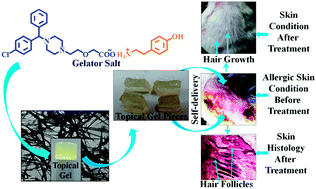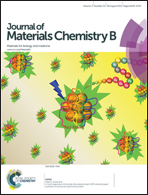Cetirizine derived supramolecular topical gel in action: rational design, characterization and in vivo self-delivery application in treating skin allergy in mice†
Abstract
A conventional drug delivery system requires a delivery vehicle which often faces various problems such as inefficient drug loading into the delivery vehicle and its release, cytotoxicity and biodegradability of the delivery vehicle, etc., whereas a supramolecular gel based self-delivery system delivers a gelator drug at the target site without using any vehicle thereby getting rid of such problems. Here, a simple salt formation strategy has been employed to convert a well known anti-allergic drug (cetirizine) to a supramolecular gelator for the purpose of making a topical gel for in vivo self-delivery applications. The salt of cetirizine and tyramine (salt 3) displays excellent gelation properties in methylsalicylate/menthol. The gels are characterised by electron microscopy, and table top- and dynamic rheology. The gelator salt 3 displays excellent physiological stability in phosphate buffer saline (PBS) and it is biocompatible in mouse macrophage RAW 264.7 and mouse myoblast C2C12 cell lines. A methylsalicylate/menthol topical gel of salt 3 is successfully self-delivered in treating the 2,4-dinitrochlorobenzene (DNCB)-induced allergic skin condition in mice.


 Please wait while we load your content...
Please wait while we load your content...